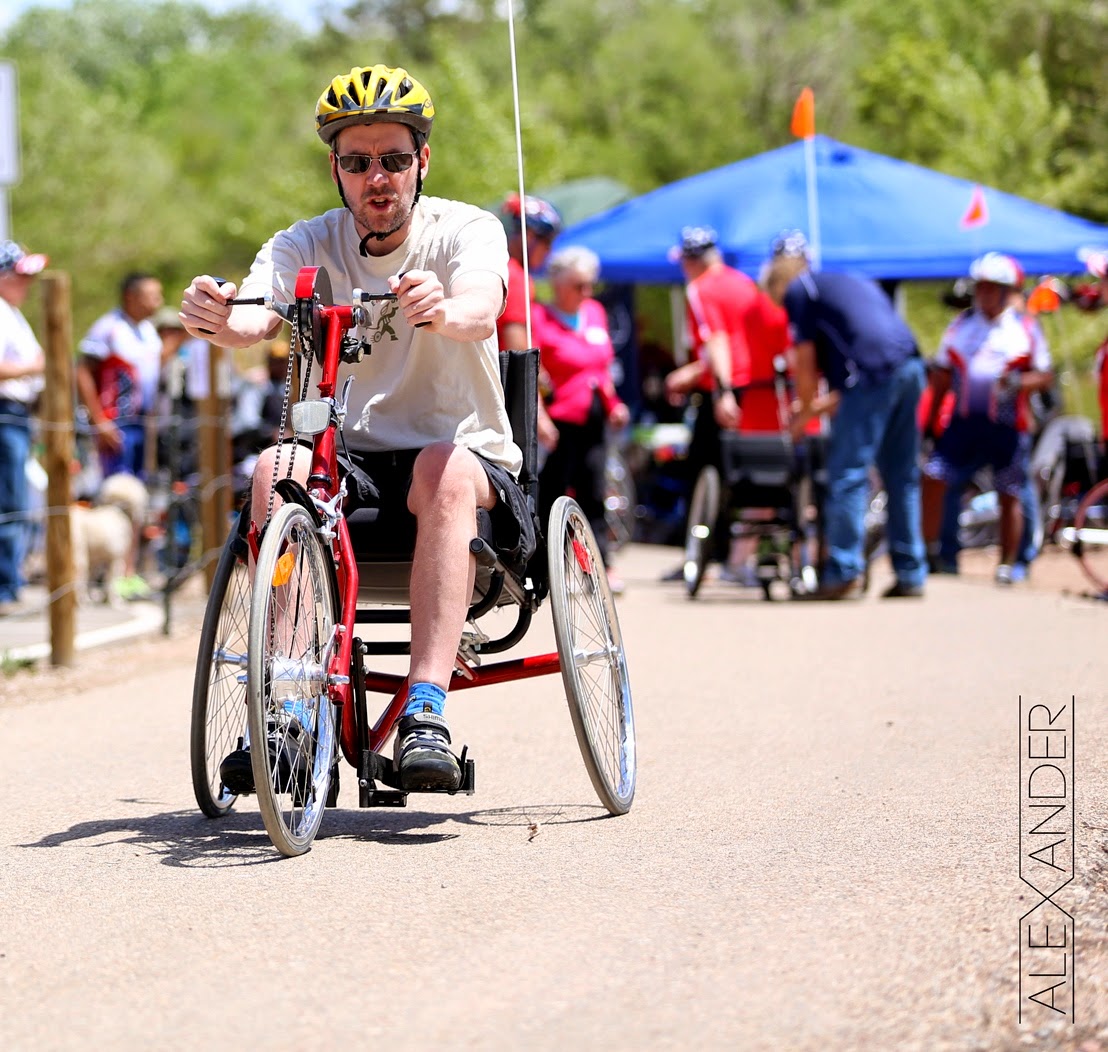Freedom on a Trike
The
moment I start cranking, feelings of liberation, glee, freedom overpowered my
multiple sclerosis. MS, what MS? And then in the next moment, feelings of
terror and dread took over. For the first time I was “pedaling” a hand-powered
adult trike. The breeze of speed weaved its way through the vents of my bike
helmet, its strap still crusty with five-year-old sweat from my last ride on a two-wheeled
bicycle. All was right with the world. Until, that is, I reached cruising
speed, when I realized that I had overlooked one minor item. How to stop this
particular hand-powered adult trike.
“Um,
where the hell are the brakes?!” I called back to Jackie, a physical therapist
at the US Veteran’s Administration. The VA was hosting a day of adaptive
cycling for disabled veterans and others with disabilities and I was giddy to
get the opportunity. Before riding I had noticed that a few of the other cycles
had hand brakes connected to the hand crank, but this trike was, by all
appearances, brake free. A hand-guided, hand-powered missile traveling at,
well, subsonic speeds of 7-9 mph.
“Just
turn the hand crank backward,” she hollered. “And be careful not to accidentally
do that when you coast or you’ll stop.”
Crisis
averted.
For
the afternoon I got to test four trikes in total, two hand-powered and two
foot-powered. Each had their plusses and minuses, and can best be described in
terms of far faster, far larger, gasoline-powered motor vehicles.
The
Convertible Sports Car. All of the foot-powered trikes out for demonstration
were set up with two wheels in front and one in the rear (a “tadpole” design). My
first ride of the day was on a silver Catrike Villager, and it felt like
driving an open-air sports car. With my wonky legs, it wasn’t a drag racer
(alas, no leg-powered bike of mine would ever burn rubber at the strip), but it
was quick and snappy and hella fun. Turns were immediate and stable while the
seating was comfortable—low, but not too low. Operating the trike, with the
steering by your hips, felt natural. I breezed the mile down the trail on my
fresh legs to the designated turnaround point and wanted to blow by the
volunteers to keep exploring. But since the event was billed as a day to
experiment with different trikes, not to abscond with them, I pulled a U and
headed back.
The
School Bus. The first hand trike I tried, a generic version, was an upright
model with a tall bench seat that was decidedly old school, which is probably
why it felt like driving a school bus. Not that I’ve ever driven a school bus,
but I’ve got a pretty good idea that one lumbers along like this trike. With two
wheels in back and one wheel in front (a “delta” design), you crank and steer
at the same time. Going in reverse slowed or stopped the cycle, triggering a
large stop sign to swing out and red lights to start flashing. Or at least so
it seemed—the trike felt heavy. Hills were challenging, requiring a good bit of
effort to climb even in the easiest gears … and even more attention to descend.
Being so upright was not very stable and braking while turning didn’t feel
natural at all.
 The
SUV. The Terra Trike Rambler wanted to be a sporty SUV (think BMW or Infiniti),
versatile with a bit of panache. Alas, it felt a bit more pedestrian on this
test ride. The higher seating position, a trademark of Terra Trikes, should
have made entry and egress rather easy, but that would be wrong. The distance
from the axle (which you have to stand in front of to mount the bike) to the
seat is considerable, so you fall into the seat rather than lower into the seat.
The higher seating position also meant sacrifices in handling. It just felt a bit
clumsy and not quite up to the Catrike (fair enough, the Catrike is at least a
third pricier). Because clip-less pedals were not available that day for the
Rambler, folks had to use ace bandages (“the duct tape of physical
therapists!”) to wrap my feet to the pedals. And being attached to the pedals
is rather important. If a foot slides off, it could slide under the trike. If
your foot slides under the trike, odds are rather high it’s going to hurt. A
lot. Consider clip-less pedals mandatory for all foot-powered trikes.
The
SUV. The Terra Trike Rambler wanted to be a sporty SUV (think BMW or Infiniti),
versatile with a bit of panache. Alas, it felt a bit more pedestrian on this
test ride. The higher seating position, a trademark of Terra Trikes, should
have made entry and egress rather easy, but that would be wrong. The distance
from the axle (which you have to stand in front of to mount the bike) to the
seat is considerable, so you fall into the seat rather than lower into the seat.
The higher seating position also meant sacrifices in handling. It just felt a bit
clumsy and not quite up to the Catrike (fair enough, the Catrike is at least a
third pricier). Because clip-less pedals were not available that day for the
Rambler, folks had to use ace bandages (“the duct tape of physical
therapists!”) to wrap my feet to the pedals. And being attached to the pedals
is rather important. If a foot slides off, it could slide under the trike. If
your foot slides under the trike, odds are rather high it’s going to hurt. A
lot. Consider clip-less pedals mandatory for all foot-powered trikes.
The
Muscle Car. I far preferred this lower slung hand trike, the Top End Force 2
from Invacare, to my school bus. Although it had a larger turning radius and it
was more challenging to wriggle out of the seat, the speed of the trike was
addicting. These brakes were on the crank, so they spun with your arms, making
them more intuitive to use. But with this V8, I rarely braked, flooring it
instead. The trike didn’t feel especially spry or nimble, but it was fast and
liked the open throttle. To get up to speed, I spooled through the many gears—which,
it should be noted, is a bit awkward, since shifting is done on the center shaft,
meaning that you have to remove one hand from the crank (which is also where
you steer). Once I reached cruising altitude (a muscle car that flies!), Jackie
informed me that it was time to stow my tray table and return my seat to its
upright position. Doh! I didn’t want the afternoon to end.
The
entire experience was fabulous. Jackie and others at the VA (thanks Michelle!)
ensured the event went smoothly, and the volunteers were more than up to the
task. I’ve got to give a shout out in particular to Charlie, owner of
Albuquerque’s Two Wheel Drive (http://twowheeldrive.com/).
To my knowledge, his shop sells more trikes in New Mexico than any other
cycling store, and Charlie knows his stuff. Note, most of the photos you see
here are courtesy of Alexander Tran, another volunteer. (www.alexanderphotographyNM.com).





Comments
AMF
Christine Haamscher
Do they need more beta testers? LOL!
Good luck, David
Far different from my old banana-
seat Schwinn!
Surprised you didn't put playing cards in the spokes.
Looks fun as I haven't ridden a bike in years.
Thanks for sharing.
----------------
Enjoyed this article about adult trikes. I just purchased a Jorvik Adult Trike from England. It is a 6 speed Trike. It really moves easily even on small inclines. Have owned it for less than one week. It certainly took some practice to adapt from a 2 wheel bike to an adult trike. But, after a few trips up and down my driveway. Riding into my flowers and rose bushes I got the hanG of it. I have used daily and put about 6 miles a day on the trike. I take it out in the morning, early afternoon and late afternoon. 2 mile rides each time. Don't hesitate to ride a trike especially with MS and balance concerns. You will not regret it at all.